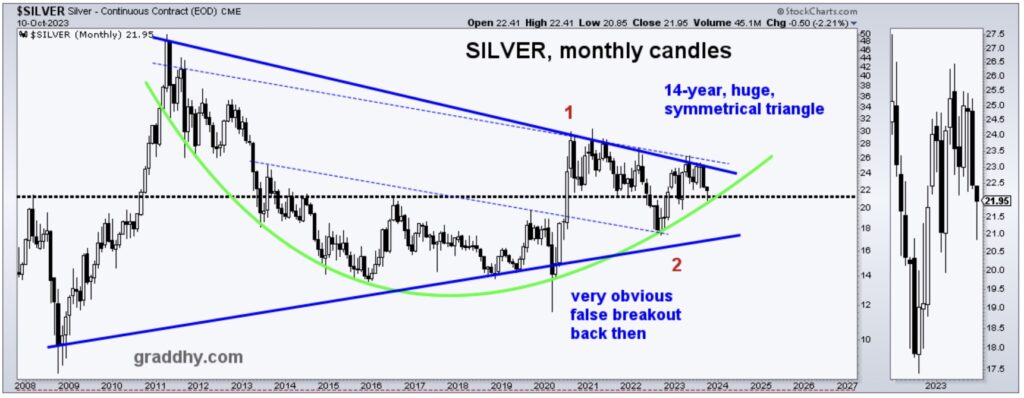With the metals continuing to rally after the recent shenanigans in the paper market, silver is now looking fantastic! Plus $65-$70 for a steak?
October 12 (King World News) – Graddhy out of Sweden: Very big picture, silver is looking fantastic. And once that upper blue line is cleared, it will be on its way.
Silver Is Looking Fantastic!
Once Blue Line Is Breached On The Upside The Race To $50 Begins!
That is at present a bullish reversal exactly where we want to see one.
GENERATIONAL opportunity…
ALERT:
Legendary investors are buying share of a company very few people know about. To find out which company CLICK HERE OR ON THE IMAGE BELOW.
 Sponsored
Sponsored
How Long Can This Continue?
Peter Boockvar: I do pin some of the rise in long term rates since late July when the BoJ announced the widening to yield curve control (which I think was the main reason), to QT, not just in the US but elsewhere. Yes, when we saw QE1 and QE2 rates rose too but that was a reflation trade and with different circumstances. The big question is how long can QT continue on before the financial plumbing starts to clog up. What level of bank reserves is the ‘right’ level? Some argue $2.5 trillion vs the $3.15 trillion now. How much more will their RRP facility shrink? We’ll see and Roberto Perli, who basically runs the Fed’s System Open Market Account that trades the Fed’s balance sheet, said Monday “Recently, our implementation framework has confronted a number of stress tests and performed quite well. This is all encouraging, but we remain cognizant of the risks and uncertainties ahead.”
QT Failure Part 2
As we’ve seen QT only once before and it ended in failure, there is not like there is a wide body of historical experience here but I will bet this one ends in failure too. I define failure as things cracking in the financial system well before the Fed’s balance shrinks by much and we’re left with this perpetually large Fed presence in the markets. And, let’s take this one step further, the Fed might be forced to revert back to QE just to help absorb the massive amount of Treasury supply coming down the DC pike. For perspective, the Fed’s balance sheet in February 2020 was at $4.16 trillion vs just under $8 trillion today. If the balance sheet since February 2020 just grew in line with nominal GDP (obviously goosed by the inflation and fiscal largesse since), it would stand instead today at $5.19 trillion. I see no chance it gets anywhere close to that during this QT process.
While more Fed members (now Kashkari) are acknowledging the tightening impact of higher long term interest rates, like a 100 bps rise in the average 30 yr mortgage rate since the last July rate hike that I talked about a month ago as reason to stop, Michelle Bowman speaking in Morocco today again said that the current rate of inflation above their 2% target, state of the tight labor market and that “domestic spending has continued at a strong pace…This suggests that the policy rate may need to rise further and stay restrictive for some time to return inflation to the FOMC’s goal.”
She did however acknowledge that “Financial market conditions have certainly tightened. That allows us a little bit of patience; that we can continue to watch as economic conditions and financial conditions continue to evolve.” In totality, listening to all the Fed speak over the past few weeks, and while Jay Powell will be the finally decision maker, I think there is no chance they hike rates in November and the fed funds futures has the odds at about 20%. AGAIN, either way, higher for longer is a continuous form of monetary tightening, joined by QT, that will ensnare more and more households and companies as debt comes due and future projects get shelved…
ALERT:
Legendary investors are buying share of a company very few people know about. To find out which company CLICK HERE OR ON THE IMAGE BELOW.
 Sponsored
Sponsored
Reaching The Breaking Point On Home Pricing
In the September NY Fed’s Consumer Expectations survey seen yesterday, the one yr and three yr inflation expectations rose one tenth and two tenths respectively to 3.7% and 3.0%. The 5 yr guess slipped by two tenths to 2.8%. Keeping the shorter term expectations from rising further was the drop in price gain expectations for college to 5.8% from a large 8.2% seen last month. There was slight slippage in price estimates for gasoline, medical care and rent but rose for food. As for homes, price gain guesses were 3% vs 3.1% in August. It’s truly upside down that price gains continue with mortgage rates approaching 8% but I think we’re reaching a breaking point on pricing.
With regards to the labor market, the mean probability that the US unemployment rate will be up in one yr rose 1.6 percentage points to 40.1% but that’s in line with the one yr average. There was a drop in those expecting a loss of one’s job. Income expectations rose a touch and consumer spending estimates were unchanged.
Here were the key comments on credit access and paying back debt and both weakened further but slightly m/o/m: “The share of households reporting that it is more difficult to obtain credit now than a year ago increased, while the share reporting that it is easier declined. Similarly, respondents’ views about future credit availability deteriorated slightly.” Those surveyed also expect a further tightening in credit conditions. On paying back a loan, “The average perceived probability of missing a minimum debt payment over the next three months increased by 1.4 percentage points to 12.5%, the highest reading since May 2020. The increase was largest for respondents below the age of 40, with some college education, and those with an annual household income below $50k.”
This whole analysis on how much consumers have in ‘excess savings’ needs to be differentiated among income groups and we have to understand too that even those with ‘excess savings’ can still change their spending behavior in response to the sticker shock of inflation and nervousness about the macro environment with both leading to a slowdown in spending.
$65-$70 For A Steak?
To the last point, who agrees with me that spending $65-70 for a steak nowadays is absolutely ridiculous?
Pepsi in yesterday’s earnings call said this on the consumer, “I do think that we see the consumer right now being more selective, and you see it in a variety of ways, right? You see some trade-down in terms of channels of trade that they’re purchasing products in. You see some orientation toward value…we think our revenue outlook accommodates an increasingly cautious consumer next year.”
With respect to their inflation expectations, “if you think of pre pandemic inflation being kind of in that 2%, 3% range, inflation is going to be a little elevated relative to that and our pricing will be roughly in line with inflation.”
Luxury Spending Tumbles
On the higher end of luxury, LVMH said yesterday, “After three roaring years and outstanding years, growth is converging toward numbers that are more in line with the historical average.” The stock is down 6% today in Paris in response to the slowdown in Q3 sales growth.
Hovering Near Lowest Level Since 1995
In the face of another rise in mortgage rates, the MBA said purchase and refi applications rose .7% and .3% w/o/w respectively after about 6% drops last week. That purchase figure is off the lowest level since 1995.
ALSO JUST RELEASED: A New All-Time High, But This Is Not Good News CLICK HERE
ALSO JUST RELEASED: The Beautiful Gold Reversal And The Most Important Chart CLICK HERE
ALSO JUST RELEASED: It’s Getting Really Bad Out There CLICK HERE
ALSO JUST RELEASED: At All Costs Remain Focused On The Big Picture CLICK HERE
ALSO RELEASED: Art Cashin – Markets Ultra Complicated After Attack On Israel, Boockvar Also Weighs In CLICK HERE
ALSO RELEASED: BUCKLE UP: A World Hurtling Toward The Inflationary End-Game CLICK HERE
ALSO RELEASED: This Crisis Today Is Multiples Worse Than What The World Faced In The 1970s CLICK HERE
To listen to James Turk discuss what to expect from paper assets, gold, silver, stocks and bonds CLICK HERE OR ON THE IMAGE BELOW.
© 2023 by King World News®. All Rights Reserved. This material may not be published, broadcast, rewritten, or redistributed. However, linking directly to the articles is permitted and encouraged.









